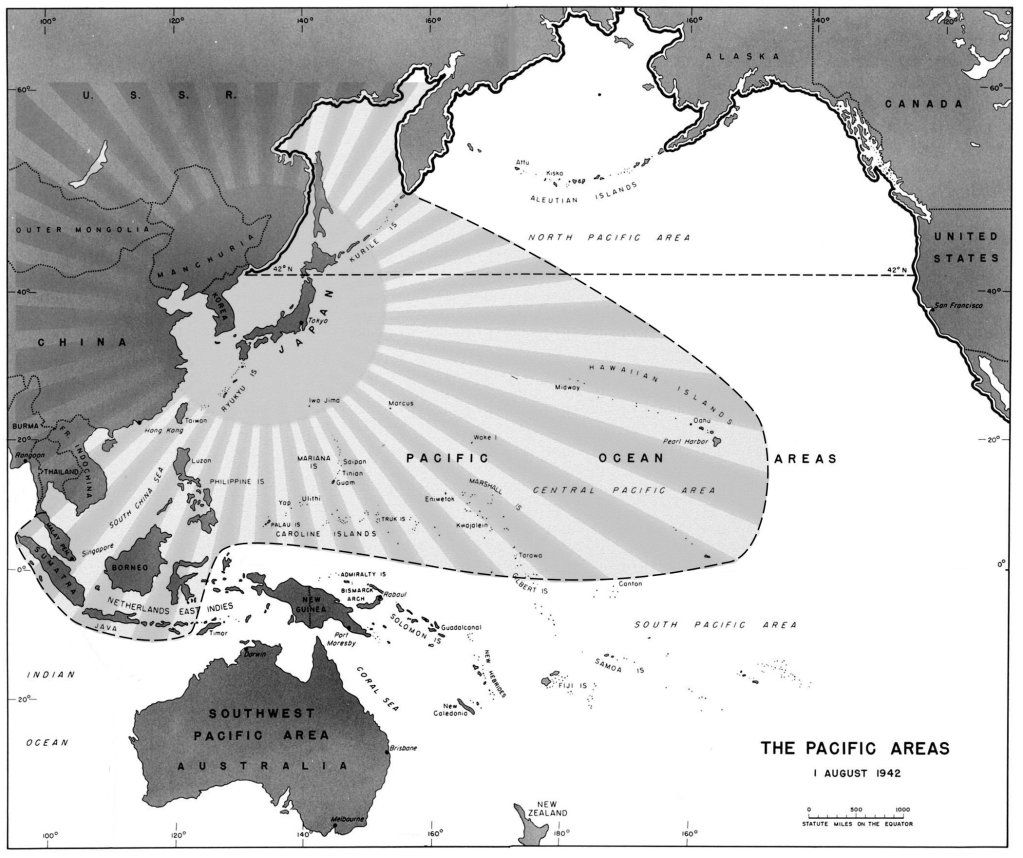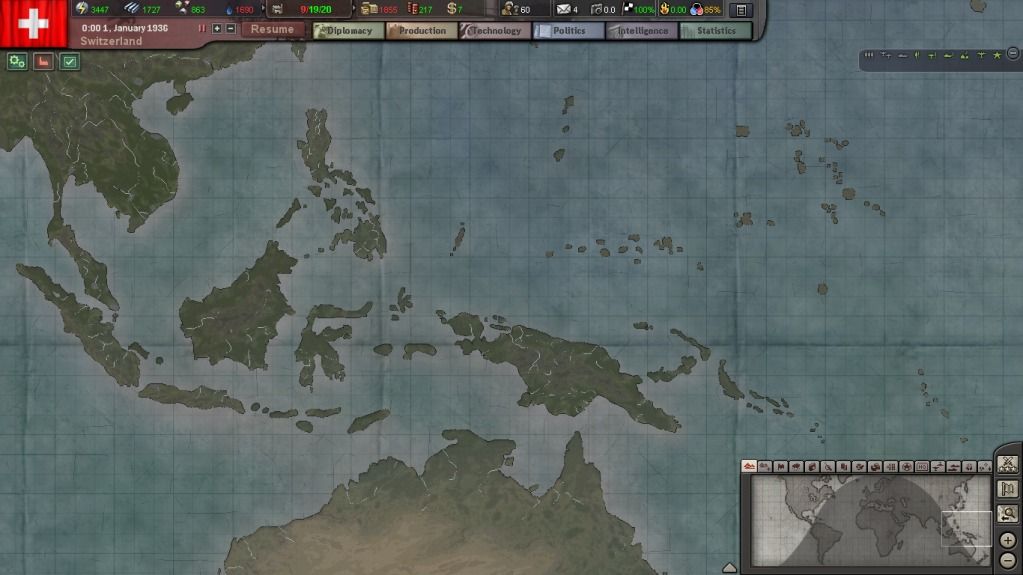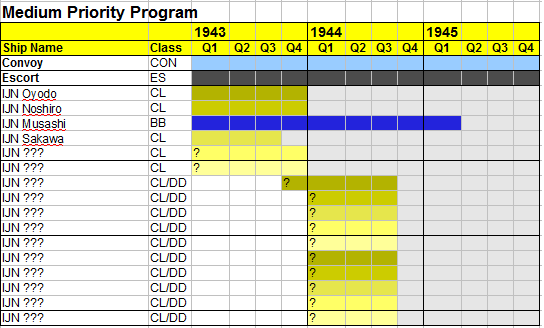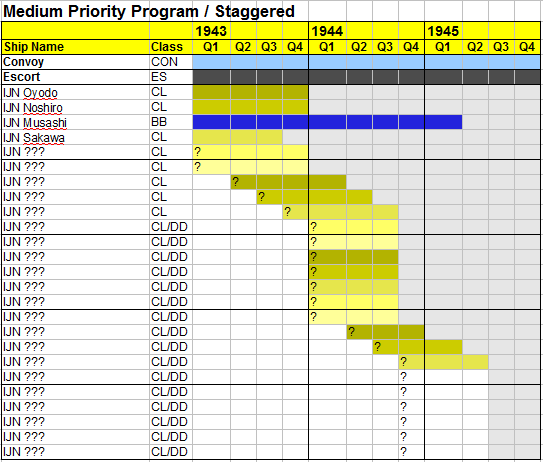Strategic Doctrine for the Prosecution of the Naval War Against the Allies
With the entry of the British Commonwealth to the Americans in the pacific Imperial Japan has a just Cassius Belli to occupy the Malayan Peninsular which for the most part should resolve resource shortages in oil and metal needed to fund our recent industrial expansion. Yet their entry has breeched the carefully constructed pacific defense perimeter (PDP) forcing us to rebuild it to protect internal shipping and the home islands.
Our war at sea is not one of aggression, and only needs to prosecuted to insure that island assets are secure and protected against enemy invasion. To this end in a practical sense we only need to sail when we need to, when we are threatened.
The concept of the PDP was to insure that we take away the Allies ability to threaten us by occupying their major bases in the region. Against the Americans we have already done this with Hawaii meaning that it looks like they can only supply naval invasions via the Bering Sea and Aleutians, however there is a threat that there is another route via the south pacific island bases. Still, they have lost their main supply base.
For the British their main supply base is Singapore. With this in our hands their ability to threaten us with invasion is reduced immensely. China should be out of their range meaning that like Hawaii if we are to see a British invasion against us it will be more than likely to be at Palau, Borneo or to recapture Singapore. This means that we know more or less exactly where our enemies are forced to attack. Thus we know exactly what ground and seas we need to prepare so that when the enemy do turn up it is fighting on our terms.
My entire strategy focuses around making it too costly to attack our holdings and to solidify our position rather than attempting a global domination victory which we know from the industrial potentials of our adversary is impossible.
As such even attempting to try and rally blows with our opponents is utter folly, since for them that is exactly the kind of approach that they want. They know that we cannot out produce them, therefore even if it costs them 5 ships to sink 1 of ours they are breaking even. This is why we need to aim to conduct as few a naval engagement as possible. The longer we retain our strength, the longer we remain at a parity to conduct operations.
We must also consider how their war budget will change if we start sinking ships. As it stands the Royal Navy has some modern, and some outdated vessels, but if we were sinking ships in number, the Royal navy will feel threatened, meaning more of the Allied budget will be poured into shipbuilding, meaning that in two years or so from now we shall be facing even more modern allied ships because we gave them the incentive to build more by sinking what we could now.
I would rather that we leave the Royal and other allied navies thinking that they have the ships for the job in the current year, then spur them onto a mass ship production program.
All this helps us maintain parity with their navies.
Thus any actions that are not fought for us with all the odds on our side are squandering our resources. This includes the current proposal for attempting to blockade Singapore*.
Key Points;
1. The IJN will attempt to retain its asserts for future use.
2. IJN Engagements will be minimised to the absolute necessary.
3. Where we do Engage it will be in counter offensive roles only.
4. We will prepare the likely regions of engagement to be favourable to us.
Strategic Points;
A. The ports of Honolulu and Singapore are occupied to deny them to our enemies
more than for our own use.
B. The rest of Indonesia past the Celebus Sea is beyond an easily defensible PDP at this time;
The new PDP should be constructed thus.
C. An airbase in the north of Sumartra allows Rangoon port to be continually threatened by bombers attacking the port. Without Singapore or Oosthaven, much of the Allied fleets will be forced to base from here. Hence giving a much better opportunity to sink Allied fleets in the pacific than at sea.
D. The Australian Ports will be an issue if we start moving in those waters, since they are close to their home ports. We should avoid a Papua Campaign until we have the assets for them. The ports of note are Port Moresby (Lv.4), Adm.Is.(Lv.5) and Rabaul (Lv.7) ;
These represent a fairly major hazard, since unlike the other allied ports we would require three separate operations to remove these bases from the Allies roster. In our long term goals, this is a necessity to eventually secure a full PDP, at which point all major Allied ports would be under our control, giving us the pacific initiative. However we do not have anything near the level of assets able to conduct this campaign. Hence we avoid these waters like plague.
E. Truk and Palau are generally vulnerable to allied invasion attempts. However we must recognise that they are not the best locales for us to base to or from because of this, and their exposed position regarding merchant shipping. They are not points we should consider strategic, rather than as liabilities. Kwaligen/Entiok. Saipan, Hawaii are far more strategic to us.
Operational Doctrine:
With a PDP, our aim is to wait for the allies to come to us, targets like Truk or Palau look ripe and juicy for allied commanders, and they will be under pressure to perform. As we have done in the past, once an invasion has began, we have been able to concentrate our fleets and air wings on location to maximum effect.
With us having to maintain fleets at both ends of the pacific, this becomes and even greater necessity. The further Japan attempts to take ground in the pacific, the fewer and fewer ships we shall have to guard waters. The more engagements fought, mean fewer ships still. This is why it makes more sense to wait for the Allied fleets to come to us. We don't want to going looking for trouble.
If we conduct local operations we will get overwhelmed piecemeal. But so long as our fleets can work together with integrated support, the Allies should never be able to overwhelm us with numbers, because while they may have large numbers to throw at us in the future, we will be using our full force against smaller elements of their own.
If we go with this PDP, and it's the best I can see at the moment to conserve our limited assets we could seriously do with a production strategy that works with it prefering an investment strategy in ships over modernisation.
Production Strategies:
Modernisation:
A brief overview of rocket projects;
Lv.1. Rocket Artillery
Lv.2. -No Research Team Proposals-
Lv.3. Strategic Rocket Design/Radar Guided Missiles & Bombs**
Lv.4. Flying Bombs
Lv.5. Surface-to-air missiles / Air-to-air missiles
Lv.6. Jet Engines$
**Greatly improves ground attack roles for light aircraft, as well as sea attack for naval aircraft
$A super powerful engine allowing strong interception ability for such aircraft.
Note: The Administration shall need to confirm if they are right or not, since I believe my version doesn't have quite the same costs.
My suggestion is that we build a prefab testing building to deploy on our site. Thus building two rocket test sites in the current production budget once we have laid the groundwork on the first. Thus in six months we shall be able to access radar guided ordinance since it looks like we are almost within making this theory a reality. This should certainly improve our position towards the end of this year, meaning we go into '44 with the very best in air ordinance.
Then for the latter half of a year three sites, giving access to Jet Engines for construction in early '44, and our first jet aircraft for the end of that year or early '45. That is if we wish to follow this investment program at these costs.
This gives us room and flexibility enough to produce a mechanised corps alongside this investment. Over the course of this coming year. Given that no more emphasis is placed on shipbuilding.
I am against building medium armour, because such units are only of any good use on the plains of China or central Manchuria. Both these areas we already control. Pure mechanised infantry is a much better route, particularly given our expertise in armoured car design.
Overall it is this admirals opinion that the modernisation route is looking less profitable given divisions over purpose, and overarching strategy. It is this admirals opinion if this route is followed, we should only follow it to produce next generation aircraft ordinance and mechanised forces. Rather than going the full hog. That means we do not put all our eggs in one basket, allowing industry to be freed up for more tactical purposes.
Shipbuilding:
This program should concentrate on numbers of cruisers over capitals. While we spent many years researching for modern battleships, we should have laid two when we had the chance. However I am in two minds as to if we should lay the second planned battleship, since its been several months even more, practical has been lost, and we must consider the fact that there may likely be overruns meaning that this second hull may not be produced in good time. On the other hand, we want to go into the closing stages of this war with a fine navy.
Still we can produce a fine navy of modern light ships.
The Americans and British can outproduce us in naval aviation by a long way. Because of this, our long term strategy needs to realise that in years from now we will be fighting against a much stronger enemy air force. Therefore a step up in cruiser production is what I might favour since they offer good all round balance. If we opt for such a strategy, we could fit another cruiser into the budget, as well as a destroyer flotilla if the army would let us. Although on that last one we might wish to upgrade its design beforehand. Thus I would not favour any production of destroyers at this time.
Such a program would see the following build outlays (in rough terms);
There is no High Priority program, as that would turn over pretty much all available IC to the IJN for the next three years. It goes without saying that the IJA would never accept such a production plan, however it would allow us two capital ships for a similar amount of escorts as the medium production plan. Or another 6-8 escorts on top of the staggered plan.
The main question is whether to accept either of the medium production plans, since the low priority is what we are already embarked on.
Only the low priority plan guarantees the army large scale funds to raise new corps. If either of the medium plans were prosecuted then that would leave the army having to decide between infrastructure or new corps.
Either sets of programs leave a small amount of IC for small changes in tactical need.
Summery:
Let me stress however whatever strategy we do choose cannot be 'half hearted'. Therefore what we decide this quarter or next fixes the entire rest of the war as far as we can see it conducted;
1. The IJN can seek to hold the PDP (as highlighted) with the low priority build plan so long as we don't act rashly and squander our ships.
2. We would rather need one of the two medium plans if we wished to deal with the Australian threat and conduct a solid Papua campaign without risk.
3. If we attempt a Papua campaign with the low priority build plan we take a serious gamble because a single series of bad battles could cost us the ships needed to keep solid deterrent fleets.
4. There will be no chance of the IJN being able to fund any naval operations around Burma without one of the medium plans, AND a suitable air investment.
5. A low priority plan, allows 1/3rd of our modernisation programs to go ahead. Either; Mechanised Corps, or Next Generation Air Ordinance.
6. A solid modernisation program allows all three modernisation programs, but it does mean we are more or less limited to our current position in the pacific that will likely decay with time (but we would be impossible to oust from China-Manchuria and the home islands).
7. A modernisation program would allow total radar coverage of the home islands as well as strong tough jet fighters. Thus even if the Pacific holdings were ever lost, then no aggressor would be able to invade Japan or bomb us into submission (so long as air assets are retained).
Japan must develop a strategy for the post war state of affairs. Either we hope not to loose pacific holdings, and develop a state of the art ground and air-force for if that comes to pass. Or we pro-actively defend the pacific seeking to keep the allies so far from the home islands, and without bases they realise this Great Power with wither war for years to come and the Allies will have to whittle us away piece by piece before they can threaten us at home.
Overall, our aim is to force a stalemate based on strength of position. NOT on strength of arms.
Our research plans must be tailored to one of these two production plans.
I wish to repeat that last statement to the army. We cannot follow separate choices between the army and navy any more. We need a combined research and production plan tailored to one of these two strategies.
Tactical Concerns will be considered once we have chosen and overall strategy to follow. This admiral will not approve any document plans for this quarter until this is done. Since it strongly affects his stance on tactical matters.
----------------------------------------------------------------------------------------------
*Although there are some good elements in setting up a trap to sink ships with our air power.






